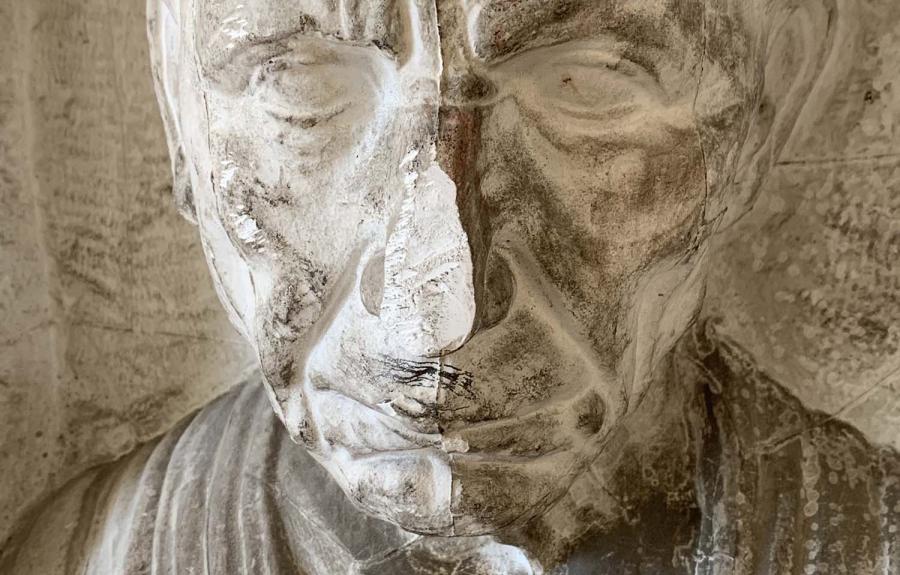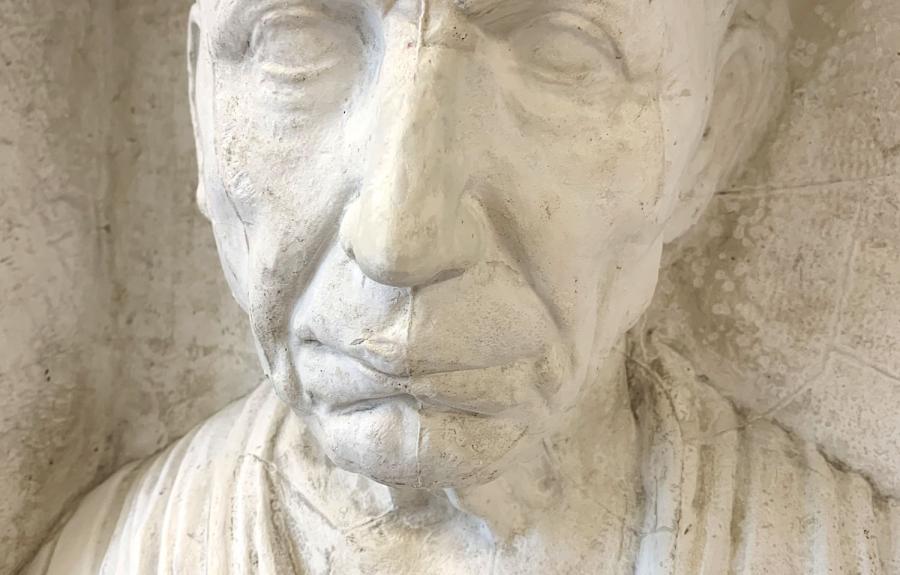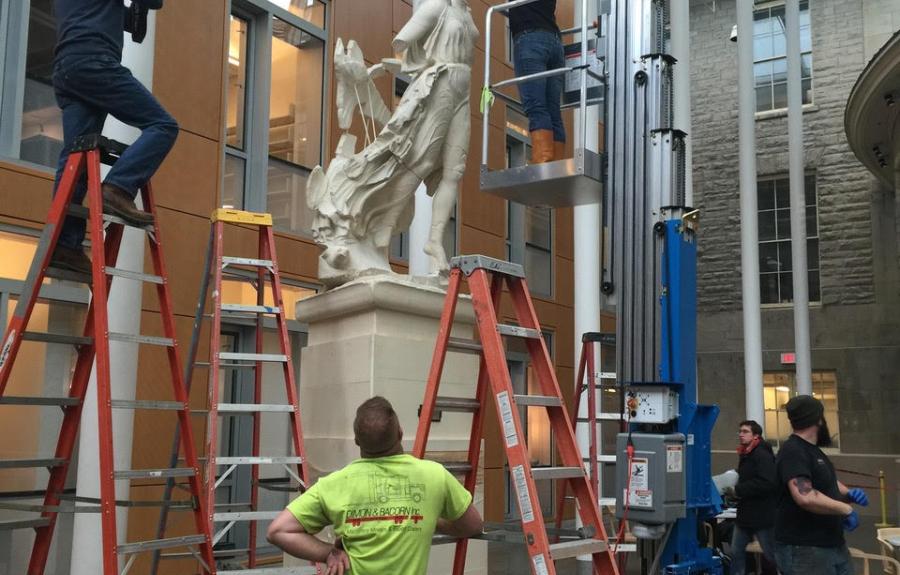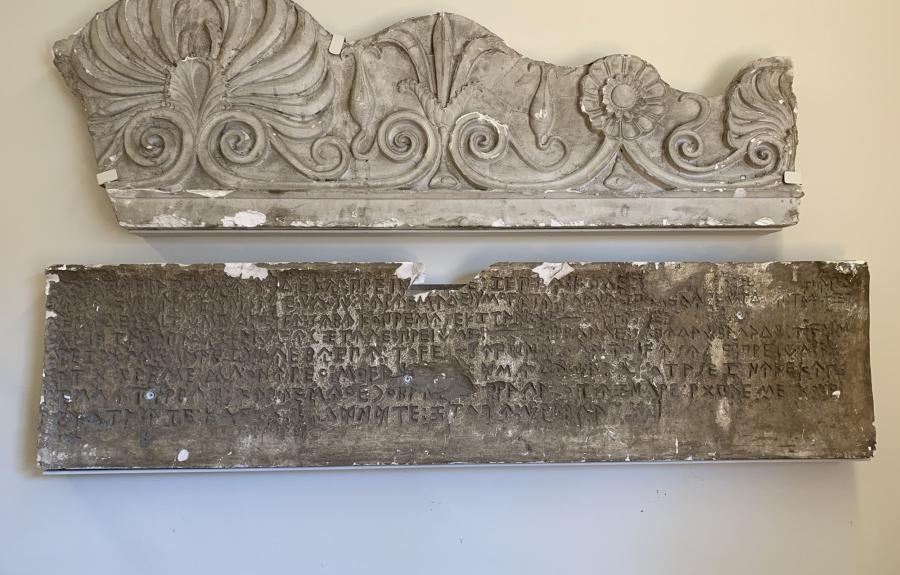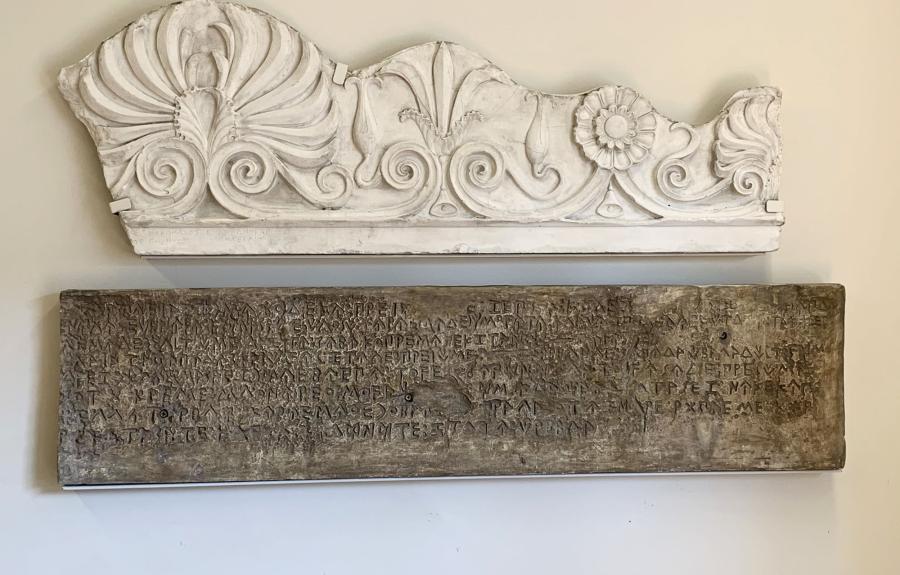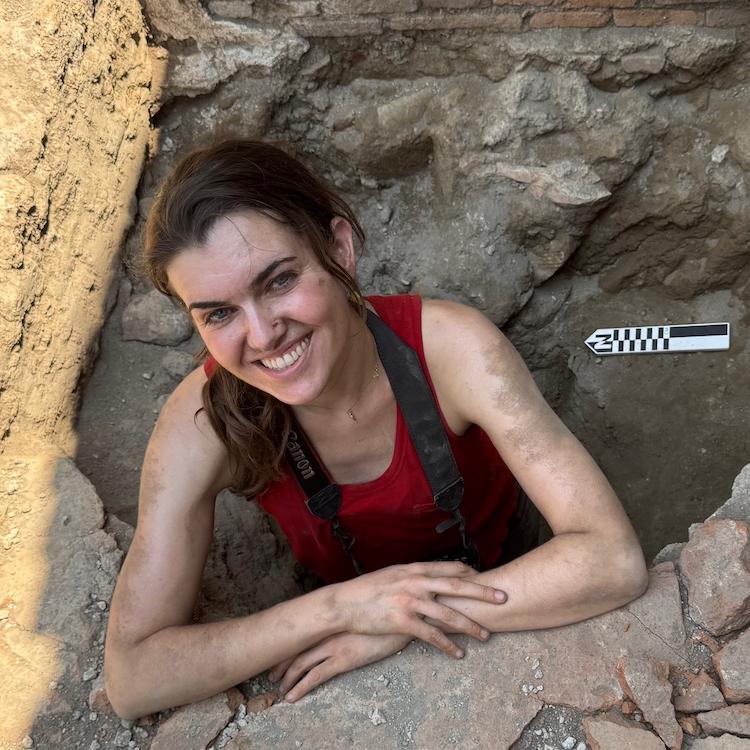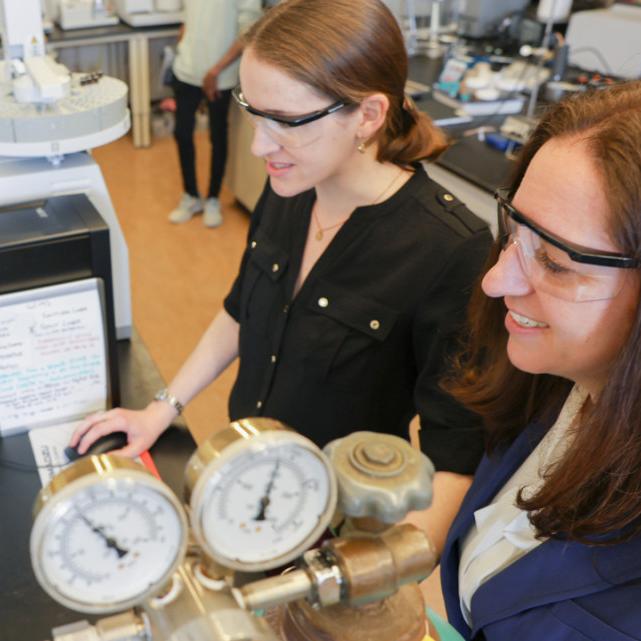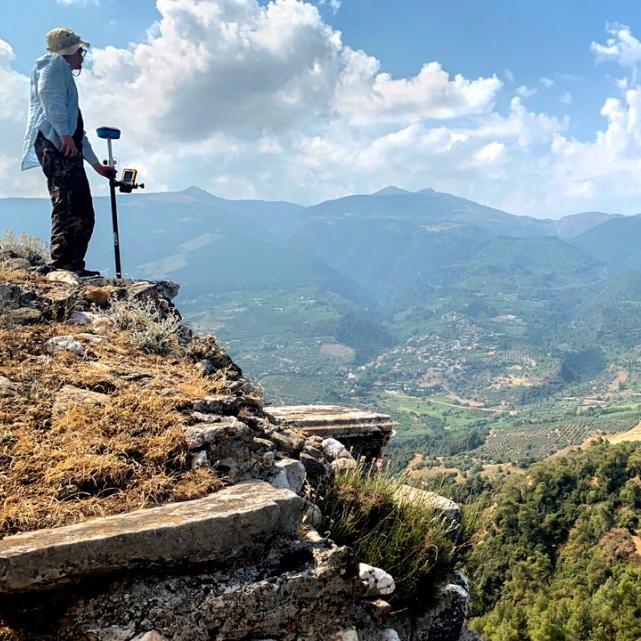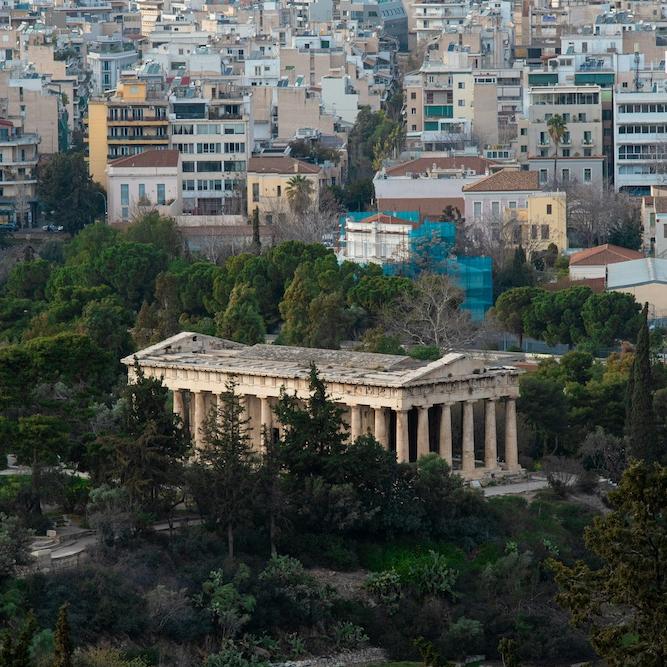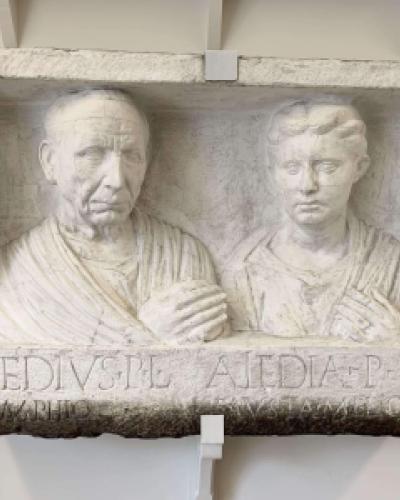The plaster casts in Goldwin Smith 122 and 124, two of the Classics Department’s seminar rooms, will have a fresh new look when students return in the fall. Kasia Maroney, a local art conservator with over twenty years of experience, recently completed the process of cleaning and restoring the casts, removing decades of grime and repairing badly chipped sections so that the collection of eighteen casts can be enjoyed for many years to come.
The process of conserving casts takes both scientific knowledge and artistic skill, as Kasia must avoid damaging the objects while making her repairs as seamless and inconspicuous as possible. While working on the Goldwin Smith casts, she began with a thorough cleaning of the gypsum plaster. She describes this process: “To use gypsum as a casting material, the mineral is heated in a kiln to drive off 75% of its chemically-bound water, at which point a fine powder results that can then be re-mixed with water to form a casting slurry. The re-introduction of water causes the plaster powder to re-harden into a solid form that has the same chemical formula as naturally occurring gypsum, but with a finer texture. The newly constituted gypsum, while it has the same composition and many of the same qualities as naturally occurring gypsum, has a much more open and lacy crystal structure. And that leaves it quite physically vulnerable to moisture and foreign material working their way into the surface. Raw plaster is difficult to clean, as any impurities typically settle quite far down into the porous gypsum material, and wet cleaning methods sometimes drive the impurities even further into the material. So dry methods are first attempted, including pressurized air, a vacuum, rubber groom sticks and erasers, and vulcanized dry-cleaning sponges. Because the surface pores are sealed and covered, painted and waxed casts lend themselves better to damp cleanings, both with distilled water and surfactant, and sometimes with light solvent poultices. Of course, the goal of treatment is always to clean the original surfaces to the greatest extent possible without risking damage to original material. Any aggressive methods or abrasive materials are avoided.”
Kasia 4_edit.jpg
Alt Text
Plaster cast before restorationPlaster cast before restoration
Kasia 5_edit.jpg
Alt Text
Plaster cast after restorationPlaster cast after restoration
In addition to being cleaned, many of the casts also required repairs in places where they had become badly chipped or, as in the case of one particular Lycian tomb inscription, the steel casting support had become exposed. Kasia explains, “All the chipped and missing areas of plaster were reconstructed with either gypsum plaster over a barrier layer, polymer resin, or water-soluble synthetic plaster, depending on the volume of loss and the required malleability of the new material. Then color was touched in with acrylic emulsions dulled with matting agents, to help blend the restorations. Abraded areas on the original surfaces were carefully and conservatively in-painted with watercolors, using a pointillist technique under magnification, to ensure minimal addition of new pigment.”
These casts are not the only projects Kasia has worked on for Cornell Classics. She was first contacted in 2008 by Associate Professor Annetta Alexandridis, curator of the Cornell Plaster Collection, who was seeking her opinion on the possibility of restoring the damaged casts so that they could be taken out of their storage facility and used for education and display on campus. Professor Verity Platt soon joined on as co-curator and, as Kasia puts it, “the two have been a powerhouse of energy and ideas, actively lifting this important collection back into a visible place at Cornell’s College of Arts and Sciences.”
Kasia recalls some of her earlier work on the Cornell plaster casts: “The first cast that we treated was small: a life-sized classical head that had been in a professor’s office for decades and had been recently smashed. But we quickly moved on to some bigger objects. Next was the Charioteer of Delphi, which is the full-size terra cotta cast to the left side of the entryway stairs inside Goldwin Smith Hall. A full treatment of the Uffizi Wrestlers (now in the Friedman Wrestling Center) and several other individual projects were followed by treatments of groups of casts for exhibitions that were installed at the Tompkins County Public Library, the old Chilled Water Plant at Cornell, and the Johnson Museum of Art. The casts displayed in Klarman Hall are offshoots of those exhibitions.”
Kasia has also contributed education about art conservation at Cornell, leading student workshops on the treatment and restoration of the plaster cast collection. Some students have even had the opportunity to create mini exhibitions for display in Goldwin Smith’s hallways.
When asked to describe some of her favorite projects as well as some of her most challenging ones, Kasia said that they are one and the same: “My favorite projects have been the ones that have also been the biggest challenges. The Flying Nike of Paionios, now soaring over the Temple of Zeus Cafe in Klarman Hall, first came to me in shards and pieces, with most of her waist missing. She inspired me to develop a new technique for building large sections of missing, weight-bearing plaster, which involves fiberglass cloth soaked in archival adhesive and applied from inside a hollow cast. But even after they’re restored and preserved, these casts are extremely fragile. The day we used rigging to install that Nike eighteen feet over the concrete floor where she now resides, I insisted we practice twice on the ground, so everyone would know their places when we got up in the air on ladders and lifts. The other Nikes in Klarman Hall were also some of my favorites. Sculpting nine missing fingers for the Capitoline Venus cast, by using photos of the original as a guide, was a wonderful challenge of gesture and subtlety. One of the trio of casts of dancers from the Villa of the Papyri at Herculaneum sent me on a mission to the Penn Museum in Philadelphia, to mold a missing foot of one of the dancers from their cast of the same sculpture. A cast of Orestes and Elektra came to me in over sixty pieces and missing most of its base. The projects that have required the most problem-solving have been the most rewarding ones.”
Kasia1.jpg
Alt Text
Installation of Nike in Klarman HallInstallation of Nike in Klarman Hall
The casts in Goldwin Smith 122 and 124 may not have posed quite the same challenge as balancing Nike on her pedestal eighteen feet in the air, but Kasia still found the work gratifying. She says, “Because the classrooms are typically quite busy, they never before afforded us an opportunity to move scaffolding and equipment in for two weeks to address the casts’ material needs without interruptions to classes. This is a small gift that this year’s COVID restrictions have given us. Because the classrooms were largely empty during this semester, it was a perfect opportunity for me to finally spend a series of days cleaning and restoring these casts.”
Kasia takes her work very seriously and always approaches a new job with a specific goal in mind and a step-by-step plan to make that goal a reality. But there is a reward for her efforts: “Once the plan is in place and the treatment is underway, I love the quiet experience of simply getting to intimately know the physical subtleties of a work of art. There’s a certain possession I come to feel of the works I treat. I see objects at their worst, and the opportunity to hold that confidence and develop a kinship with an absent artist can feel immensely personal. Art conservation is rooted in respect and restraint. If I have done my job well, it should look like I was never there at all. But the artworks I treat become a part of me. And truly the best part of being a conservator is the satisfaction that comes with knowing that they can now be fully seen and appreciated by others for generations to come.”
Kasia 2_edit.jpg
Alt Text
Plaster casts before restorationPlaster casts before restoration
Kasia 3_edit.jpg
Alt Text
Plaster casts after restorationPlaster casts after restoration
The newly restored casts are on display now in Goldwin Smith Hall. More of Kasia’s conservation work can be seen on her website here.

